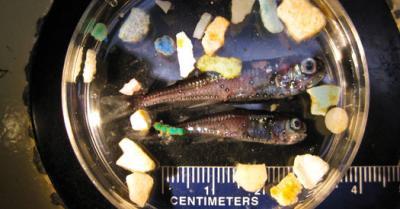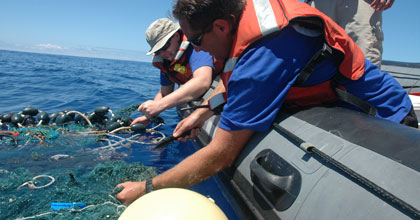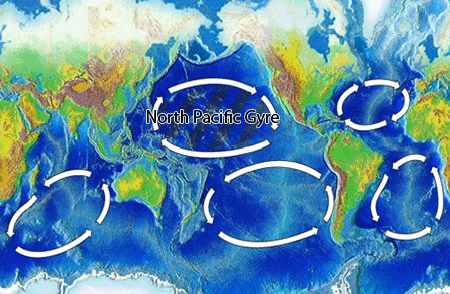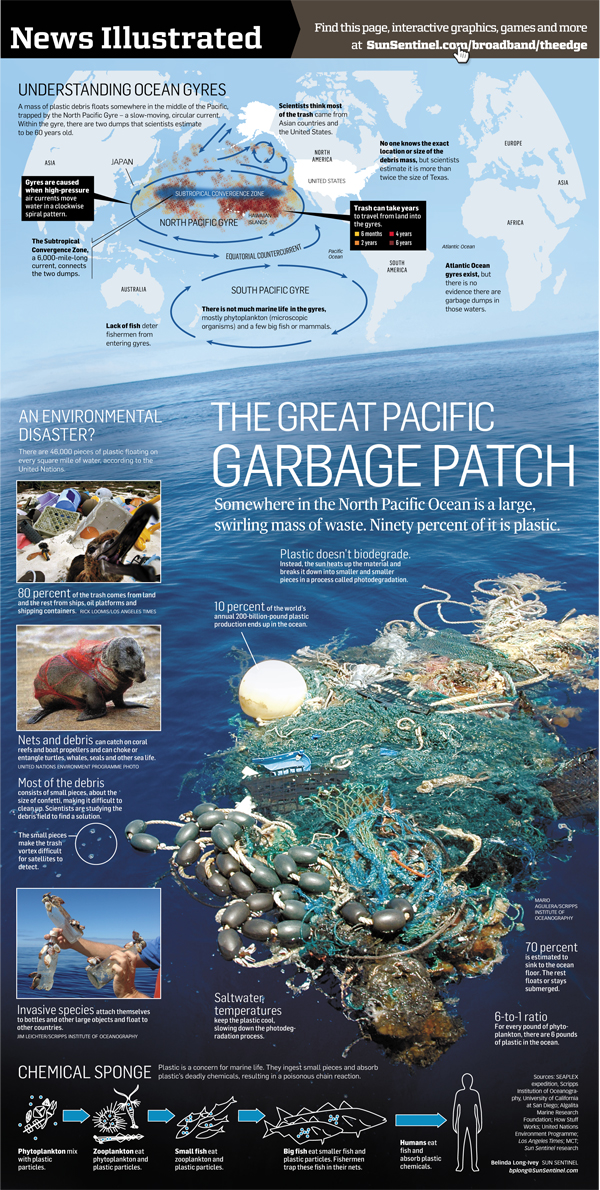Plastic found in nine percent of ‘Garbage Patch’ fishes: Tens of thousands of tons of debris annually ingested

The first scientific results from an ambitious voyage led by a group of graduate students from Scripps Institution of Oceanography at UC San Diego offer a stark view of human pollution and its infiltration of an area of the ocean that has been labeled as the "Great Pacific Garbage Patch."
Researchers from the Scripps Environmental Accumulation of Plastic Expedition, or SEAPLEX, found evidence of plastic waste in more than nine percent of the stomachs of fish collected during their voyage to the North Pacific Subtropical Gyre. Based on their evidence, researchers estimate that fish in the intermediate ocean depths of the North Pacific ingest plastic at a rate of roughly 12,000- to 24,000 tons per year.
Their results were published June 27 in the journal Marine Ecology Progress Series.

During the SEAPLEX voyage in August 2009, a team of Scripps graduate students traveled more than 1,000 miles west of California to the eastern sector of the North Pacific Subtropical Gyre aboard the Scripps research vessel New Horizon. Over 20 days the students, New Horizon crew and expedition volunteers conducted comprehensive and rigorous scientific sampling at numerous locations. They collected fish specimens, water samples and marine debris at depths ranging from the sea surface to thousands of feet depth (SEAPLEX Oceanographic Equipment).

Of the 141 fishes spanning 27 species dissected in the study, they found that 9.2 percent of the stomach contents of mid-water fishes contained plastic debris, primarily broken-down bits smaller than a human fingernail. The researchers say the majority of the stomach plastic pieces were so small their origin could not be determined.

The authors say previous studies on fish and plastic ingestion may have included so-called "net-feeding" biases. Net feeding can lead to artificially high cases of plastic ingestion by fishes while they are confined in a net with a high concentration of plastic debris. The Scripps study's results were designed to avoid such bias. The highest concentrations of plastic were retrieved by a surface collecting device called a "manta net," which sampled for only 15 minutes at a time. The short sampling time minimizes the risk of net feeding by preventing large concentrations of plastic from building up, and also by reducing the amount of time that a captured fish spends in the net. In addition to the manta net, the fishes were also collected with other nets that sample deeper in the water column where there is less plastic to be ingested through net feeding.
The new study focused on the prevalence of plastic ingestion, but effects such as toxicological impacts on fish and composition of the plastic were outside of the study's goals.
Rather than a visible "patch" or "island" of trash, marine debris is highly dispersed across thousands of miles of the North Pacific Subtropical Gyre. The debris area cannot be mapped from air or space, so SEAPLEX researchers collected samples in 132 net tows (130 of which contained plastic) across a distance of more than 2,375 kilometers (1,700 miles) in an attempt to find the boundaries of the patch. The region, a "convergence zone" where floating debris in water congregates, is generally avoided by mariners due to its calm winds and mild currents. The North Pacific Subtropical Gyre has been understudied by scientists, leaving many open questions about marine debris in the area and its long-term effects on the marine environment. (ScrippsNews)

Charles Moore has estimated the mass of the Great Pacific Garbage Patch at 100 million tons.
The Great Pacific Garbage Patch, also described as the Pacific Trash Vortex, is a gyre of marine litter in the central North Pacific Ocean located roughly between 135° to 155°W and 35°N to 42°N. The patch extends over an indeterminate area, with estimates ranging very widely depending on the degree of plastic concentration used to define the affected area.
The Patch is characterized by exceptionally high concentrations of pelagic plastics, chemical sludge, and other debris that have been trapped by the currents of the North Pacific Gyre. Despite its size and density, the patch is not visible from satellite photography since it primarily consists of suspended particulates in the upper water column. Since plastics break down to ever smaller polymers, concentrations of submerged particles are not visible from space, nor do they appear as a continuous debris field. Instead, the patch is defined as an area in which the mass of plastic debris in the upper water column is significantly higher than average.

sandy commented on The Watchers:
Thanks for writing about this. Glad there are still some people like you who value our world’s oceans. Maybe the least we can do is disposing of our items properly. Check this video out. http://youtu.be/qQUECrYE2bY